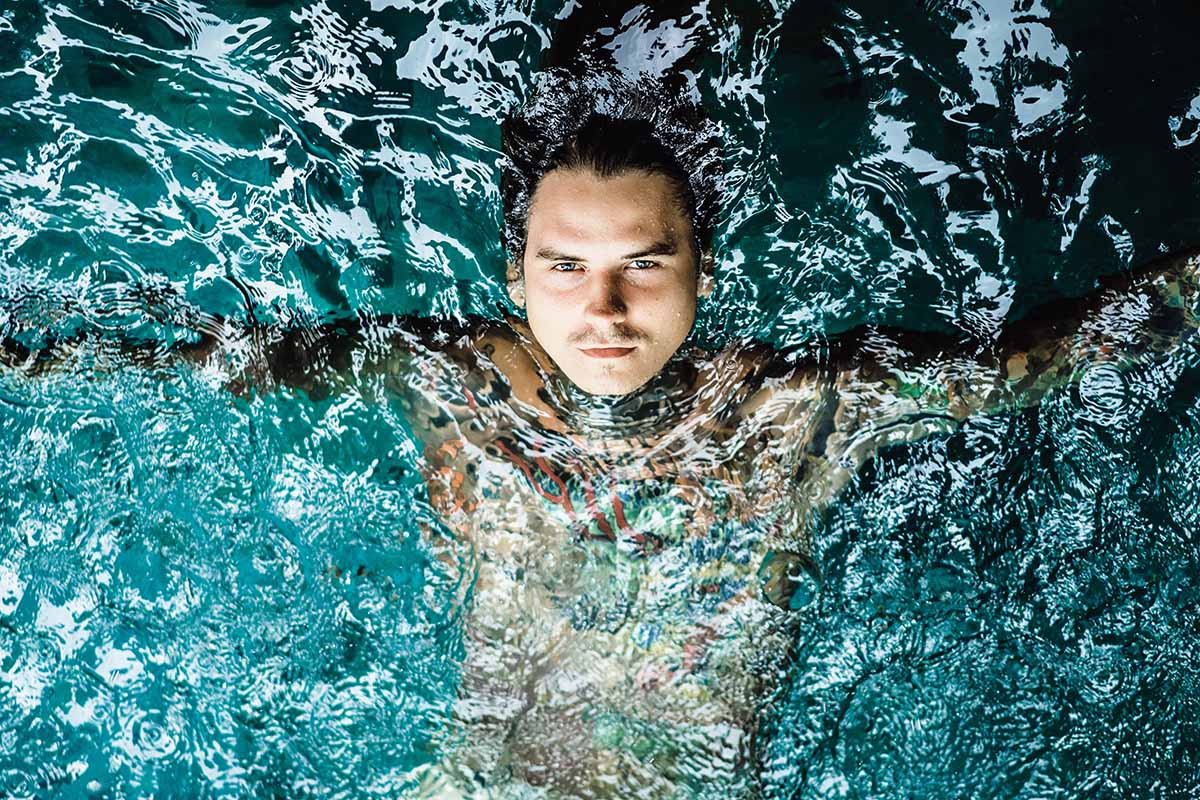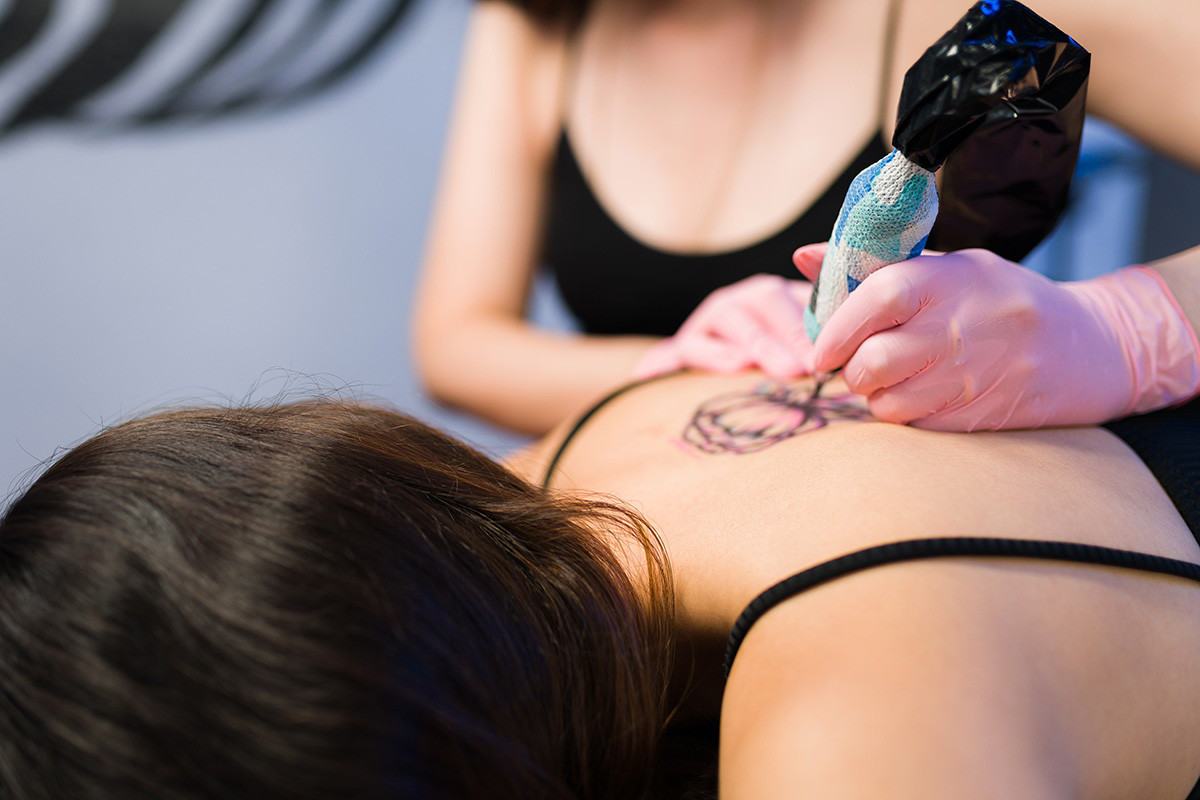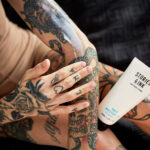Just got inked? Wondering how long before you can show off your new body art at the beach or pool? Tattoo aftercare is crucial, and at tattooat.com, we’re here to guide you through it. Knowing How Long To Wait To Get In Water After Tattoo ensures your skin art heals beautifully, preventing infections and preserving vibrant colors. With the right knowledge and care, your skin art will remain a stunning expression of your individuality for years to come.
1. Tattoo Healing Process: When Can You Swim?
Getting a new tattoo is thrilling, but remember, proper aftercare is critical for your skin’s health and your tattoo’s appearance. Tattoo artists often recommend waiting at least 2-4 weeks before submerging new ink in pools, hot tubs, or open water. But why? New tattoos are essentially open wounds. Exposing them to water too soon can lead to bacterial infections, skin irritation, and damage to the tattoo design.
Healing times vary based on factors like tattoo size, location, skin type, and aftercare quality. Understanding the healing stages and factors affecting healing time is key to a great outcome.
1.1. What are the Stages of Tattoo Healing?
The tattoo healing process involves several stages:
- Week 1: Swelling, pain, and oozing are common.
- Week 2: Itching and peeling begin.
- Weeks 3-4: Continued aftercare, with full healing taking 2-4 weeks, but sometimes up to 6 months.
Avoiding swimming and activities that irritate the skin is vital during these stages. Open water poses the highest risk of bacterial infection, which can delay healing and damage your ink. Patience is key.
1.2. What Factors Affect Tattoo Healing Time?
Several factors influence how long a tattoo takes to heal:
| Factor | Influence |
|---|---|
| Size of the Tattoo | Larger tattoos take longer to heal due to the greater area of skin affected. |
| Location on Body | Areas with more movement or friction (like joints) may heal slower. |
| Quality of Aftercare | Proper cleaning and moisturizing are essential for reducing healing time and preventing complications. |
| Individual Skin Type | Different skin types heal at different rates; some may be more prone to irritation or infection. |
| Health & Lifestyle | Factors like immune system strength, diet, hydration, and whether you smoke can significantly affect how quickly and well your tattoo heals. A healthy lifestyle supports faster and more effective healing. |
Monitor your tattoo closely and consult your tattoo artist if you have concerns about its healing progress. They can offer personalized advice based on your specific situation.
 A person getting a new tattoo and the healing process
A person getting a new tattoo and the healing process
Alt text: Tattoo artist applying stencil to client’s arm, highlighting the initial stage of the tattoo process and the importance of proper aftercare for optimal healing.
2. Fresh Tattoo: What are the Risks of Swimming?
Swimming with a fresh tattoo can lead to several issues. Water can dry out the skin, causing itching, flaking, and scabbing. This can result in fading, patchiness, and blurred lines in your new ink, which no one wants.
Beyond physical discomfort, swimming with a fresh tattoo increases the risk of bacterial infections. Pools, lakes, and oceans are full of bacteria, and your healing tattoo is an open wound vulnerable to these invaders.
2.1. Why are Bacterial Infections a Concern with Open Wounds?
Tattoos break the skin, introducing ink into the body, making them open wounds. Submerging a healing tattoo in water exposes it to bacteria in pools, lakes, and oceans. This can cause irritation, infection, and complications that harm your tattoo and prolong healing.
Keeping your new tattoo clean and protected from water exposure is essential. Waterproof dressings and bandages can shield your tattoo from bacteria while swimming, but they aren’t foolproof.
2.2. How do Chlorine and Salt Water Impact New Tattoos?
Chlorine and salt water negatively affect fresh tattoos, potentially leading to:
| Effect | Description |
|---|---|
| Irritation | Both chlorine and salt can irritate the sensitive, healing skin around a new tattoo. |
| Fading | Exposure to these elements can cause the ink to fade prematurely. |
| Discoloration | The tattoo’s colors may become altered or less vibrant. |
| Ink Leaching | Water, especially with chlorine or salt, can draw ink out of the tattoo, affecting its long-term appearance. |
Even in chlorinated pools, chlorine doesn’t kill all bacteria, posing a risk to healing tattoos. Additionally, both chlorine and salt water dry out the skin, exacerbating irritation and prolonging healing.
3. Swimming with a New Tattoo: How to Protect It?
If you must swim before your tattoo is fully healed, take precautions. Waterproof dressings and bandages can shield your tattoo from water and bacteria, though this isn’t ideal. Remove the dressing immediately after swimming and clean your tattoo thoroughly to minimize infection risk.
Swimming with a fresh tattoo isn’t recommended, and precautions don’t guarantee safety from infection or damage. Waiting until your tattoo is fully healed is always best, but if you must swim, protect your art.
3.1. What Waterproof Dressings and Bandages Should I Use?
Waterproof dressings and bandages create a barrier between your tattoo and water, protecting your new ink from bacteria and contaminants. Some top options include:
- Saniderm Tattoo Aftercare Bandage
- Recovery Derm Shield Tattoo Aftercare Bandage
- Tattoo Aftercare Waterproof Bandage
- Nexcare Tattoo Bandages
- Nuanchu Waterproof Bandage
Apply the dressing before swimming and remove it immediately after, changing it regularly to ensure your tattoo remains protected.
3.2. Post-Swim Tattoo Care: What’s Essential?
After swimming, cleaning and caring for your tattoo minimizes infection and damage risks. Here’s a step-by-step guide:
- Gently wash the tattoo with warm water and mild, fragrance-free soap.
- Pat the area dry with a clean, soft towel.
- Apply a thin layer of fragrance-free moisturizer to hydrate the skin and promote healing.
Post-swim care is crucial for maintaining your tattoo’s health and appearance. Protecting your new ink ensures smooth healing and keeps your tattoo looking great for years.
 A person protecting their new tattoo while swimming with waterproof dressings and bandages
A person protecting their new tattoo while swimming with waterproof dressings and bandages
Alt text: An individual applies a waterproof bandage over a fresh arm tattoo before swimming, highlighting protective measures for aquatic activities during the tattoo healing period.
4. Tattoo Ready for Swimming: What are the Signs?
Once your tattoo is fully healed, you can safely swim without worry. Key signs include:
- Absence of redness
- No itching
- No scabbing
- No flaking
- Smooth, even appearance
If unsure, consult your tattoo artist or a medical professional before swimming. They can assess healing progress and advise on when it’s safe to swim.
4.1. What Visual Indicators Should I Look For?
Visual indicators are crucial for determining if your tattoo is ready for swimming. Look for:
- No bubbling or degradation
- No redness or peeling
- Smooth, even appearance
- Absence of flaking or scabbing
If your tattoo meets these criteria, it’s likely healed and safe to expose to water. Remember, everyone heals differently, so monitor your tattoo closely.
4.2. Why Should I Consult My Tattoo Artist?
Your tattoo artist is invaluable in determining if your tattoo is ready for swimming. They have experience with the healing process and can assess your tattoo’s progress.
If unsure, visit the studio where you got your tattoo and have a professional check it. It’s always better to be cautious and ensure your tattoo is fully healed before swimming.
5. Alternative Water Activities: How to Stay Cool?
Want to get in the water while your tattoo heals without risking damage? Consider these alternative activities:
- Gentle Showers: Opt for quick, gentle showers instead of baths to minimize soaking the tattoo.
- Avoid Direct Water Jets: Position yourself to avoid direct water pressure on the tattooed area.
- Boiled Tap Water Cleansing: Use cooled, boiled tap water for cleaning the tattoo to reduce infection risk.
Keeping your new tattoo clean and protected during healing is essential. Choosing alternative water activities lets you enjoy the water while ensuring your tattoo heals properly.
6. Hot Tubs, Saunas, and Other Water Hazards: What to Avoid?
Hot tubs and saunas can pose risks to new tattoos. The warm, moist environment increases bacterial infection risk and hinders tattoo healing. Waiting at least 3-4 weeks after getting a tattoo before entering a hot tub or sauna is recommended.
Avoiding these environments during healing protects your tattoo and ensures proper healing. Once fully healed, you can enjoy all water activities without worry.
According to research from Portland State University’s Art Department, in July 2023, tattoos are artistic expressions, but also wounds requiring dedicated care. Delaying exposure to potential contamination sources is paramount.
7. Tattoo Aftercare Essentials: A Quick Recap
Understanding tattoo healing and the risks of early swimming is crucial for protecting your new ink. Follow these aftercare guidelines:
- Use waterproof dressings and bandages when necessary.
- Wait until your tattoo is fully healed before swimming.
Whether you’re a seasoned ink enthusiast or getting your first tattoo, prioritize its health and safety.
At tattooat.com, we’re dedicated to providing you with the information and resources you need for optimal tattoo aftercare.
8. Beyond Swimming: Essential Tattoo Care Tips
8.1. Daily Cleaning Routine:
Maintaining a strict cleaning regimen is crucial for a smoothly healing tattoo. Here’s how to clean your tattoo every day:
- Wash Your Hands: Always start with thoroughly clean hands to prevent introducing bacteria to your tattoo.
- Gentle Washing: Use lukewarm water and a mild, fragrance-free soap to gently wash the tattooed area. Avoid harsh scrubbing.
- Pat Dry: Use a clean, soft towel to pat the area dry. Avoid rubbing, which can irritate the skin.
- Moisturize: Apply a thin layer of a fragrance-free, hypoallergenic moisturizer to keep the skin hydrated.
Cleaning should be done 2-3 times a day to ensure the area remains free of bacteria and stays moisturized, promoting optimal healing.
8.2. Moisturizing: The Key to Healing:
Keeping your tattoo moisturized is essential. Dry skin can lead to itching, cracking, and potential damage to the tattoo. Here are some guidelines for moisturizing:
- Choose the Right Moisturizer: Opt for fragrance-free, hypoallergenic lotions or balms. Products containing petroleum or lanolin can sometimes cause allergic reactions.
- Apply Thin Layers: Apply a thin layer of moisturizer to the tattoo after each cleaning. Over-moisturizing can also hinder healing by trapping moisture and bacteria.
- Regular Application: Moisturize the tattoo several times a day, especially if you notice the skin feeling dry or tight.
Proper moisturization keeps the skin supple and supports the healing process, ensuring the tattoo remains vibrant.
8.3. What Clothes Should I Wear to Protect My Tattoo?
The clothing you wear can significantly impact your tattoo’s healing. Here are some recommendations:
| Clothing Type | Recommendation |
|---|---|
| Loose-Fitting Clothes | Wear loose clothing to avoid friction against the tattoo. Tight clothes can rub against the healing skin, causing irritation and slowing healing. |
| Soft Fabrics | Choose soft, breathable fabrics like cotton. Avoid synthetic materials that can trap moisture and increase the risk of infection. |
| Protective Layers | In sunny conditions, wear clothing that covers the tattoo to protect it from UV exposure, which can fade the ink. |
Selecting the right clothing minimizes irritation, protects against the elements, and supports the healing process.
8.4. Sun Protection: Shielding Your Ink:
Protecting your tattoo from the sun is vital, both during and after healing. UV rays can fade and damage the ink. Here’s how to protect your tattoo from the sun:
- Avoid Direct Sunlight: Keep your new tattoo out of direct sunlight as much as possible during the healing process.
- Sunscreen: Once the tattoo is fully healed, use a high SPF, broad-spectrum sunscreen every time you expose the tattoo to the sun.
- Protective Clothing: Wear clothing that covers the tattoo when you know you’ll be spending time outdoors.
Sun protection helps maintain the vibrancy and clarity of your tattoo for years to come.
9. Debunking Tattoo Myths: Separating Fact from Fiction
9.1. Common Tattoo Aftercare Myths:
Several misconceptions surround tattoo aftercare. Here are a few common myths debunked:
- Myth: Tattoos need to “breathe.”
- Fact: While it’s important to avoid trapping too much moisture, tattoos need to be protected from bacteria and the environment.
- Myth: You should pick at scabs.
- Fact: Picking scabs can remove ink and cause scarring. Allow scabs to fall off naturally.
- Myth: All moisturizers are the same.
- Fact: Fragrance-free, hypoallergenic moisturizers are best. Avoid products with harsh chemicals.
9.2. Expert Recommendations vs. Old Wives’ Tales:
Rely on advice from tattoo artists and medical professionals rather than unverified sources. Expert recommendations are based on years of experience and scientific understanding, ensuring you receive the best care.
10. Exploring Tattoo Designs and Artists at Tattooat.com
Looking for inspiration for your next tattoo? Want to find a skilled artist in your area? tattooat.com is your go-to resource. Explore a vast library of tattoo designs, discover talented artists, and read in-depth articles on tattoo aftercare, styles, and history.
10.1. Finding Inspiration for Your Next Tattoo:
tattooat.com offers a wide range of tattoo designs to inspire your next piece of body art. Whether you’re into traditional, minimalist, watercolor, or geometric designs, you’ll find plenty of ideas to spark your creativity.
10.2. Connecting with Talented Tattoo Artists:
Our platform connects you with skilled tattoo artists across the United States. Browse artist profiles, view their portfolios, and find someone whose style matches your vision. We make it easy to find the perfect artist for your next tattoo.
10.3. Learning About Different Tattoo Styles:
From classic Americana to modern styles, tattooat.com offers articles and guides on various tattoo styles. Learn about the history, techniques, and characteristics of different styles to make an informed decision about your next tattoo.
Ready to explore the world of tattoos? Visit tattooat.com today to discover designs, find artists, and learn everything you need to know about getting and caring for your tattoos.
11. Addressing Common Concerns and FAQs
11.1. What if My Tattoo Shows Signs of Infection?
If you suspect your tattoo is infected, seek medical attention immediately. Signs of infection include:
- Excessive redness or swelling
- Pus or drainage
- Fever
- Increased pain
Early treatment can prevent complications and ensure your tattoo heals properly.
11.2. How Do I Protect My Tattoo in the Summer?
Summer poses unique challenges for tattoo aftercare. In addition to sun protection, stay hydrated, avoid excessive sweating, and keep your tattoo clean. Taking these precautions helps your tattoo heal well in the summer months.
12. Conclusion: Prioritizing Your Tattoo’s Health
Caring for your new tattoo requires patience, diligence, and the right information. Understanding the healing process, protecting your tattoo from water and sun, and following proper aftercare guidelines ensures your ink looks its best for years to come.
At tattooat.com, we’re committed to providing you with the knowledge and resources you need for successful tattoo aftercare. Explore our site, find inspiration, connect with talented artists, and learn everything you need to know about tattoos.
Ready to start your tattoo journey? Visit tattooat.com today!
13. FAQ: How Long to Wait to Get in Water After Tattoo
13.1. What happens if you swim while your tattoo is healing?
Swimming with a new tattoo exposes the wounded skin to bacteria, causing infections and skin irritation. Avoid swimming entirely while your tattoo is healing to protect it.
13.2. Can I swim 7 days after tattoo?
Waiting for the tattoo to fully heal, which can take at least two to four weeks, is advised before swimming.
13.3. How long after tattoo can you swim in chlorine?
Wait at least two weeks and up to four to six weeks after getting a tattoo before swimming in chlorine-filled water.
13.4. Can I use waterproof dressings to protect my tattoo while swimming?
Yes, you can use waterproof dressings, but it’s best to wait until the tattoo is fully healed.
13.5. What are the risks of swimming with a fresh tattoo?
Swimming with a fresh tattoo carries the risk of bacterial infections, skin irritation, and damage to the design.
13.6. Can I take a bath instead of swimming?
No, avoid baths with a fresh tattoo. Submerging the tattoo in water for extended periods, even in a bathtub, can increase the risk of infection and hinder the healing process. Stick to quick, gentle showers.
13.7. How often should I clean my new tattoo?
Clean your new tattoo 2-3 times a day to remove bacteria and keep the area moisturized, which promotes optimal healing.
13.8. Is it normal for my tattoo to itch during healing?
Yes, itching is normal during the healing process. However, avoid scratching the tattoo, as this can damage the skin and ink. Gently pat or tap the area to relieve itching.
13.9. Can I use petroleum-based products on my tattoo?
It’s best to avoid petroleum-based products on a new tattoo. They can trap moisture and bacteria, potentially leading to infection. Opt for fragrance-free, hypoallergenic lotions or balms.
13.10. How long will my tattoo take to fully heal?
A tattoo typically takes 2-4 weeks to heal, but it can sometimes take up to 6 months for full healing, depending on various factors like size, location, and aftercare.
Address: 1825 SW Broadway, Portland, OR 97201, United States.
Phone: +1 (503) 725-3000.
Website: tattooat.com.
